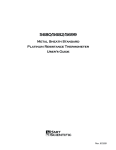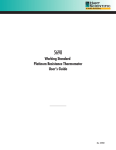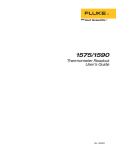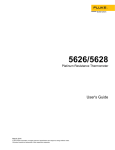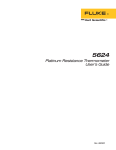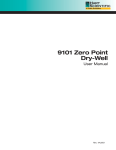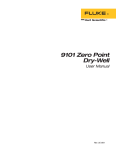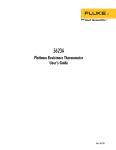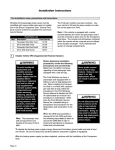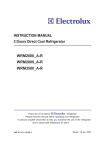Download 5680 5682 5699 User`s Guide R
Transcript
5680/5682/5699 Metal Sheath Standard Platinum Resistance Thermometer User’s Guide Rev. 492702 Copyright ©,1996 – 2000. All rights reserved. Hart Scientific 799 E. Utah Valley Drive American Fork, Utah 84003-9775 Telephone (801) 763-1600 • Fax (801) 763-1010 Internet: http://www.hartscientific.com Rev. 492702 Table of Contents 1 Before You Start . . . . . . . . . . . . . . . . . . . . . . 1 1.1 1.2 Symbols Used . . . . . . . . . . . . . . . . . . . . . . . . . 1 Safety Information . . . . . . . . . . . . . . . . . . . . . . . 2 1.2.1 1.2.2 1.3 Warnings . . . . . . . . . . . . . . . . . . . . . . . . . . . . . . . . 2 Cautions . . . . . . . . . . . . . . . . . . . . . . . . . . . . . . . . . 2 Hart Scientific Authorized Service Centers . . . . . . . . . . . 3 2 Introduction . . . . . . . . . . . . . . . . . . . . . . . . 5 2.1 2.2 2.3 General . . . . . . . . . . . . . . . . . . . . . . . . . . . . 5 Application. . . . . . . . . . . . . . . . . . . . . . . . . . . 6 Calibration . . . . . . . . . . . . . . . . . . . . . . . . . . . 6 2.3.1 2.4 2.5 Calibration Intervals . . . . . . . . . . . . . . . . . . . . . . . . . . . 6 Recalibration. . . . . . . . . . . . . . . . . . . . . . . . . . 6 Return Procedure . . . . . . . . . . . . . . . . . . . . . . . 6 3 Specifications and Warranty . . . . . . . . . . . . . . . 9 3.1 3.2 Specifications . . . . . . . . . . . . . . . . . . . . . . . . . 9 Construction . . . . . . . . . . . . . . . . . . . . . . . . . . 9 3.3 3.4 Electrical Circuit . . . . . . . . . . . . . . . . . . . . . . . . 9 Warranty . . . . . . . . . . . . . . . . . . . . . . . . . . . 10 4 Installation . . . . . . . . . . . . . . . . . . . . . . . . 11 4.1 4.2 Environmental Issues . . . . . . . . . . . . . . . . . . . . . 11 Mounting . . . . . . . . . . . . . . . . . . . . . . . . . . . 11 4.3 Lead Wire Identification . . . . . . . . . . . . . . . . . . . 11 5 SPRT Care and Handling Guidelines . . . . . . . . . . . 13 5.1 5.2 SPRT Care . . . . . . . . . . . . . . . . . . . . . . . . . . 13 SPRT Handling Guidelines . . . . . . . . . . . . . . . . . . 13 6 Operation. . . . . . . . . . . . . . . . . . . . . . . . . 15 6.1 6.2 6.3 6.4 General . . . . . . . . . . . . . . . . . . . . Comparison Calibration of Other Instruments . Immersion Requirements . . . . . . . . . . . Thermal EMF . . . . . . . . . . . . . . . . . . . . . . . . . . . . . . . . . . . . . . . . . . . . . . . . . 15 15 15 15 i 6.5 Measuring Current . . . . . . . . . . . . . . . . . . . . . . 16 6.6 Cooling Rates at High Temperatures . . . . . . . . . . . . . 16 7 Accessories. . . . . . . . . . . . . . . . . . . . . . . . 19 7.1 Case . . . . . . . . . . . . . . . . . . . . . . . . . . . . . 19 8 Troubleshooting . . . . . . . . . . . . . . . . . . . . . 21 8.1 ii Troubleshooting . . . . . . . . . . . . . . . . . . . . . . . 21 Figures and Tables Table 1 Figure 1 Table 2 Figure 2 International Electrical Symbols . . . . . . . . . . . . . . . . . . . . . . 1 5680/5682/5699 Metal Sheath Platinum Resistance Thermometer . . . . 5 Specifications. . . . . . . . . . . . . . . . . . . . . . . . . . . . . . . . 9 Circuit Schematic . . . . . . . . . . . . . . . . . . . . . . . . . . . . . 12 iii 1 Before You Start 1 1.1 Before You Start Symbols Used Table 1 lists the International Electrical Symbols. Some or all of these symbols may be used on the instrument or in this manual. Table 1 International Electrical Symbols Symbol Description AC (Alternating Current) AC-DC Battery CE Complies with European Union Directives DC Double Insulated Electric Shock Fuse PE Ground Hot Surface (Burn Hazard) Read the User’s Manual (Important Information) Off On 1 5680/5682/5699 SPRT User’s Guide Symbol Description Canadian Standards Association CAT OVERVOLTAGE (Installation) CATEGORY II, Pollution Degree 2 per IEC1010-1 refers to the level of Impulse Withstand Voltage protection provided. Equipment of OVERVOLTAGE CATEGORY II is energy-consuming equipment to be supplied from the fixed installation. Examples include household, office, and laboratory appliances. C-TIC Australian EMC Mark 1.2 Safety Information Use this instrument only as specified in this manual. Otherwise, the protection provided by the instrument may be impaired. The following definitions apply to the terms “Warning” and “Caution”. • “Warning” identifies conditions and actions that may pose hazards to the user. • “Caution” identifies conditions and actions that may damage the instrument being used. 1.2.1 Warnings To avoid personal injury, follow these guidelines. • DO NOT use this instrument to measure the temperature of any hazardous live component. • DO NOT use this unit for any application other than calibration work. • DO NOT use this unit in environments other than those listed in the user’s manual. • Use of this instrument at high temperatures for extended periods of time can cause the handle to become hot. • Follow all safety guidelines listed in the user’s manual. • Calibration Equipment should only be used by Trained Personnel. 1.2.2 Cautions To avoid possible damage to the instrument, follow these guidelines. • DO NOT remove the label from the handle. This cautions the user concerning the delicate nature of the instrument. 2 1 Before You Start • Read Section entitled “SPRT Care and Handling Guidelines” before removing the SPRT from the shipping box or case. Incorrect handling can damage the SPRT and void the warranty. • Keep the shipping container in case it is necessary to ship the SPRT. Incorrect packaging of the SPRT for shipment can cause irreparable damage. 1.3 Hart Scientific Authorized Service Centers Please contact one of the following authorized Service Centers to coordinate service on your Hart product: Hart Scientific, Inc. 799 E. Utah Valley Drive American Fork, UT 84003-9775 USA Phone: +1.801.763.1600 Telefax: +1.801.763.1010 E-mail: [email protected] Fluke Nederland B.V. Customer Support Services Science Park Eindhoven 5108 5692 EC Son NETHERLANDS Phone: +31-402-675300 Telefax: +31-402-675321 E-mail: [email protected] Fluke Int'l Corporation Service Center - Instrimpex Room 2301 Sciteck Tower 22 Jianguomenwai Dajie Chao Yang District Beijing 100004, PRC CHINA Phone: +86-10-6-512-3436 3 5680/5682/5699 SPRT User’s Guide Telefax: +86-10-6-512-3437 E-mail: [email protected] Fluke South East Asia Pte Ltd. Fluke ASEAN Regional Office Service Center 83 Clemenceau Avenue #15-15/06 Ue Square 239920 SINGAPORE Phone: +65-737-2922 Telefax: +65-737-5155 E-mail: [email protected] When contacting these Service Centers for support, please have the following information available: • Model Number • Serial Number • Voltage • Complete description of the problem 4 2 Introduction 2 2.1 Introduction General The Hart Metal Sheath Standard Platinum Resistance Thermometer (SPRT) is designed to be an excellent primary standard interpolating instrument converting temperature to resistance. Hart Scientific offers three models (5680, 5682, and 5699). Models 5680 and 5682 metal sheath SPRTs cover the International Temperature Scale of 1990 (ITS-90) range from below the Triple Point of Argon (–189°C) to 480°C. The 5699 metal sheath SPRT covers the ITS-90 range from below the Triple Point of Argon (–189°C) to 661°C. The 5680 has a resistance of 25Ω at the triple point of water (0.01°C), the 5682 has a resistance of 100Ω at the triple point of water, and the 5699 has a resistance of 25.5Ω at the triple point of water. These metal sheath SPRTs are hand constructed at Hart Scientific by experts with years of SPRT manufacturing experience. Each SPRT is carefully annealed at the appropriate temperatures and precisely tested for stability. The sensing element is fabricated using high purity platinum wire wound in a strain free design on a special frame. The 5680 and 5682 sensors are protected by a ceramic capsule. The 5699 sensor is protected by a platinum capsule. The sensors are pressure sealed with a special argon/oxygen mixed gas and fit with a terminal box handle with a strain relieved connection to the five wire cable. Gold plated spade lugs terminate the wires. Figure 1 5680/5682/5699 Metal Sheath Platinum Resistance Thermometer 5 5680/5682/5699 SPRT User’s Guide 2.2 Application Hart Scientific metal sheath SPRTs are classified as primary standards. A primary standard is defined in terms of transfer of the ITS-90 from a standards laboratory to a customer’s laboratory. Primary standards are calibrated in a standards lab using known intrinsic values. 2.3 Calibration In order for any instrument to be used as a standard it must be calibrated. The SPRT may be purchased calibrated or non-calibrated. Hart has the capability to perform fixed-point or comparison calibrations traceable to NIST. They can be economically calibrated using the comparison method or any one of several fixed-point calibrations matching ITS-90 subranges. 2.3.1 Calibration Intervals Accuracy required for the application and the condition of use dictate the calibration intervals. Calibration checks at the triple point of water should be accomplished periodically and the results recorded. Once a written history of the SPRT is available, calibration intervals can be adjusted. The SPRT does not need to be recalibrated as long as the change in resistance does not exceed the owner’s specifications. Depending on the user’s Quality Assurance requirements, the SPRT drift should be checked periodically at the Triple Point of Water (TPW). Section 8, Troubleshooting, provides information on drift with respect to mechanical shock and oxidation. If the Rtp cannot be restored after annealing to within calibration tolerances, a full recalibration should be scheduled. 2.4 Recalibration The recalibration of the SPRTs should be scheduled according to the user’s company Quality Assurance requirements. Normally, an SPRT is recalibrated annually. Unless the SPRT is used only over a limited range, calibration over the full range of the SPRT (–200°C to 480°C for the 5680 and 5682, and –200°C to 661°C for the 5699) is recommended. For information on recalibrating your SPRT, contact a Hart Scientific Authorized Service Center (see Section 1.3) for calibration options, an RMA number, and current pricing. 2.5 Return Procedure Call a Hart Scientific Authorized Service Center for an RMA number before shipping. Extreme care must be taken in shipping a SPRT. Place the thermometer in its factory provided protective storage case. Be sure the case is latched se- 2 Introduction 2 Introduction curely. Place the protective case in the original manufacturer’s wooden shipping crate or wooden crate with similar dimensions (44 1/2 in. x 11 3/4 in. x 11 3/4 in.). Place soft insulation on all sides of the crate to cushion the SPRT against mechanical shocks. The cover of the crate should be attached with screws. Labeling as extremely fragile is recommended. Whether the thermometer is returned for repair or warranty, please include a letter containing the following information • Description of the faulty operation and circumstances of failure. • Complete shipping instructions for the return of the thermometer to the customer. 7 3 Specifications and Warranty 3 3.1 Specifications and Warranty Specifications Table 2 Specifications 5680 5699 Temperature Range –200°C to 480°C Resistance Value at TPW 25.5Ω ±0.5Ω 100Ω ±1.0Ω 25.5Ω ±0.5Ω Specified Current 1 mA 1 mA or 0.5 mA 1mA Resistance Ratio W(234.3156K) ≤ 0.844235 W(302.9146K)≥ 1.11807 Sensitivity 0.1Ω/°C Stability <0.010°C/100 hours at 480°C (typically < 0.005°C) Repeatability < 2mK Diameter of Pt Sensor Wire 0.07 mm (0.003") –200°C to 661°C 0.4Ω/°C 0.1Ω/°C <8 mK per year max (typically 2–3 mK per year) < 1mK 0.04 mm (0.0016") Lead Wires 5: four sensor wires plus grounding wire Protective Sheath Inconel™ 600 Diameter: 6.35 mm (0.25") Length: 485 mm (19.1") Insulation Resistance > 100MΩ at 480°C >1000MΩ at 20°C 3.2 5682 0.07 mm (0.003") Inconel™ 600 Diameter: 5.56 mm ±0.13 mm (0.219" ±0.005") ±0.127 mm (0.005") Length: 482 mm (19") > 100MΩ at 661°C >1000MΩ at 20°C Construction The Model 5680/5682 SPRTs cover the range from –200°C to 480°C and the Model 5699 SPRT covers the range from –200°C to 661°C. The sensor elements are crafted using high purity platinum wire wound in a strain free design on a specially designed support. 3.3 Electrical Circuit The metal sheathed SPRTs are provided with a terminal box handle. The eight-foot cable has five polyethylene coated wires enclosed in a super-flex rubber jacket with a stainless steel spring strain relief. Gold plated spade 9 5680/5682/5699 SPRT User’s Guide lugs terminate the wires. The fifth wire is a ground wire which is connected to the Inconel sheath. 3.4 Warranty Hart Scientific, Inc. (Hart) warrants this product to be free from defects in material and workmanship under normal use and service for a period as stated in our current product catalog from the date of shipment. This warranty extends only to the original purchaser and shall not apply to any product which, in Hart’s sole opinion, has been subject to misuse, alteration, abuse or abnormal conditions of operation or handling. Software is warranted to operate in accordance with its programmed instructions on appropriate Hart products. It is not warranted to be error free. Hart’s obligation under this warranty is limited to repair or replacement of a product which is returned to Hart within the warranty period and is determined, upon examination by Hart, to be defective. If Hart determines that the defect or malfunction has been caused by misuse, alteration, abuse or abnormal conditions or operation or handling, Hart will repair the product and bill the purchaser for the reasonable cost of repair. To exercise this warranty, the purchaser must forward the product after calling or writing a Hart Scientific Authorized Service Center for authorization. The Service Center assumes NO risk for in-transit damage. THE FOREGOING WARRANTY IS PURCHASER’S SOLE AND EXCLUSIVE REMEDY AND IS IN LIEU OF ALL OTHER WARRANTIES, EXPRESS OR IMPLIED, INCLUDING BUT NOT LIMITED TO ANY IMPLIED WARRANTY OR MERCHANTABILITY, OR FITNESS FOR ANY PARTICULAR PURPOSE OR USE. HART SHALL NOT BE LIABLE FOR ANY SPECIAL, INDIRECT, INCIDENTAL, OR CONSEQUENTIAL DAMAGES OR LOSS WHETHER IN CONTRACT, TORT, OR OTHERWISE. 10 4 Installation 4 4.1 Installation Environmental Issues Primary standard equipment should be used in a calibration laboratory or other facility specifically designed for this purpose. Environmental requirements include: • Stable temperature and relative humidity <80% • Clean, draft-free area • Low noise level: low radio frequency, magnetic or electrical interference • Low vibration levels 4.2 Mounting Most often temperature standards, primary and secondary, are used to calibrate other temperature-sensitive equipment. The SPRT must be mounted carefully to avoid any damage to the sensor. If the fluid bath used does not have a lid designed for SPRT insertion, clamps should be used to ensure that the handle and cable are not immersed. Do not screw the clamps too tight. Over tightening will damage the sheath. If metal comparison blocks are used in the bath, maintain a close fit between the thermometer sheath and the well in the comparison block. However, allow for the thermal expansion of the thermometer sheath when determining block well tolerances. 4.3 Lead Wire Identification The Model 5680/5682/5699 SPRTs are equipped with a five-wire cable. Four lead wires are used to cancel lead wire resistance. The fifth wire is a ground wire which is connected to the Inconel sheath. For best results, the readout device should be equipped to handle four-terminal resistors. The lead wire colors are red, black, white, yellow, and green. Lead wire pairs, attached to each end of the sensor, are identified by heat shrink tubing. Red and black wires have red heat shrink tubing. Blue and white wires 11 5680/5682/5699 SPRT User’s Guide have black heat shrink tubing. The green wire is the ground wire which should be connected to the ground. See Figure 2. White Red BLACK RED Rx Yellow to ground connected to Inconel sheath GREEN Figure 2 4 Installation Black Circuit Schematic 5 SPRT Care and Handling Guidelines 5 5.1 SPRT Care and Handling Guidelines SPRT Care CAUTION: READ THIS SECTION BEFORE REMOVING THE SPRT FROM THE SHIPPING BOX OR CASE The 5680/5682/5699 Standard Platinum Resistance Thermometers (SPRTs) are extremely delicate instruments. Great care must be taken when handling the SPRT to maintain the calibration accuracy. Vibration or shock may cause the resistance to increase. A slight tap to the SPRT tip as it is removed from an instrument can cause a change in Rtp as high as 1 mK. Correct handling of the SPRT will prolong the life expectancy. When not in use, the SPRT should be stored in the protective case provided by Hart Scientific. 5.2 SPRT Handling Guidelines 1. DO keep the thermometer as clean as possible. Always remove any fluid from the sheath immediately after taking the thermometer from a bath. 2. DO immerse the thermometer in the appropriate liquid for the temperature range. If a dry block is used, the well diameter should allow the SPRT to comfortably slip in and out without excess movement. For best results, immerse the thermometer as deep as possible to avoid “stem effect” (the temperature error caused by the conduction of heat away from the sensor). Do not submerge the handles. 3. DO allow sufficient time for the thermometer to stabilize before making measurements allowing for the best accuracy. 4. DO use the correct drive current with the thermometer to prevent error in temperature or resistance. 5. DO anneal the thermometer at 480°C for the 5680 and 5682, and at 661°C for the 5699 when it has been subjected to mechanical or temperature shock. The SPRT should also be annealed before calibration. 6. DO use the protective case provided or other protection when the thermometer is not in use. 7. DON’T subject the thermometer to any physical shock or vibration. 8. DON’T subject the thermometer to temperatures above the highest specified operating temperature. 13 5680/5682/5699 SPRT User’s Guide 9. DON’T expose the thermometer’s handle or cables to extreme temperatures. 10. DON’T submerge the handle or cable in liquids. Model 5699 only 14 11. DO anneal the SPRT after delivery or when using at a temperature higher than 600°C. 12. DON’T take the SPRT out directly when it has been at a temperature higher than 500°C. Allow the SPRT to cool to a temperature less than 500°C before removing it to room temperature. See Section 6.6 for more information. 6 Operation 6 6.1 Operation General For best results, be familiar with the operation of the calibration bath or furnace and the read-out instrument. Be sure to follow the manufacturer’s instructions for the read-out instrument and the calibration bath or furnace. 6.2 Comparison Calibration of Other Instruments The uniformity and stability of the bath and the degree of accuracy required determine the number of temperature measurements necessary. However, to follow “good” practice procedures, always measure the triple point of water (Rtp) after each temperature measurement. This provides the most accurate measurement of the ratio: W (t ) = R(t ) R(tp ) Equation 1: Resistance Ratio Equation 6.3 Immersion Requirements Stem effect can cause measurement errors for any thermometer not immersed in the fluid at least 152 mm (6 inches). This error is due to heat lost or gained by the sensing element through the thermometer stem. In addition, heat losses occur due to radiation losses from the sensing element to the housing. However, the effect of the shunt resistance is insignificant. Full immersion is recommended in a furnace or freeze point cell. The immersion depth for primary standards is dependent on several factors including accuracy requirements and type of liquid. Therefore, we recommend a 203 mm (8 inch) minimum immersion depth. The exact immersion depth required can be determined by performing a gradient test taking measurements approximately every 127 mm (0.5 inch) until there is a significant difference in readings. Allow the thermometer to stabilize at each new depth. Plot the results to see the stem effect. 6.4 Thermal EMF Two factors contribute to thermal EMF, chemical consistency and physical consistency. Variations in chemical structure and discrepancies in crystal structure due to impurities can contribute to thermal EMF. These factors are minimized by annealing the full length of wire before construction of the SPRT. 15 5680/5682/5699 SPRT User’s Guide Likewise, connection to extension lead wires and readout instruments can be a source of thermal EMF. The thermal EMF is caused by a difference in temperature between two connections. If the two connections are the same temperature, there will be little or no thermal EMF effects. However, if there is a substantial temperature difference between connections, the thermal EMF effects will be significant. Therefore, cover or insulate any exposed bridge or galvanometer terminals to lessen the source of error. The effects of thermal EMF can be canceled by using an AC bridge or a DC bridge with reversible current. 6.5 Measuring Current Each SPRT has a specified drive current depending upon the particular sensor. The recommended currents are in the following table. Model Resistance Drive Current 5680 25Ω 1.0 mA 5682 100Ω 0.5 mA or 1.0 mA 5699 25Ω 1.0 mA Errors caused by self-heating of the element need to be minimized. Allowing sufficient time for the SPRT to stabilize and the heat to be dispersed into the surrounding medium will provide the most accurate results. The Model 5680/5682/5699 measurements are made at 1 mA and 1.4 mA. These measurements are then extrapolated to zero current. This can be done graphically by plotting i² vs. R and extrapolating to zero power or by using the following equation. R 0 = R1 − i12 ( R 2 − R1 ) i22 − i12 where: R0 = Zero current resistance R1 = Resistance measured at current i1 R2 = Resistance measured at current i2 Equation 2: Calculation of R0 6.6 Cooling Rates at High Temperatures The equilibrium concentration of point defects in the pure platinum wire increase exponentially to the increase in temperature. If a high cooling rate (i.e., removing a SPRT from a high temperature and cooling it to room temperature in less than a minute) occurs above 500°C, some of the point defects in the platinum wire become trapped in the crystalline structure 16 6 Operation causing a slight increase in resistance. This slight increase in resistance can be reversed by annealing the SPRT. To avoid this problem, slowly cool the SPRT at a rate of roughly 150°C/hour above 500°C before removing to room temperature. The SPRT can be safely removed from an instrument at 500°C or less and cooled to room temperature without concern for the cooling rate. 17 7 Accessories 7 7.1 Accessories Case The SPRTs are shipped in a protective case. The SPRT should be stored in this case when not in use. The SPRT should be shipped in this case when returning (see Section 2.5, Return Procedure). 19 8 Troubleshooting 8 8.1 Troubleshooting Troubleshooting In the event that the probe appears to function abnormally, this section may help to find and solve the problem. Several possible problem conditions are described along with likely causes and solutions. If a problem arises, please read this section carefully and attempt to understand and solve the problem. If the probe seems faulty or the problem cannot otherwise be solved, contact a Hart Scientific Authorized Service Center (see Section 1.3) for assistance. Be sure to have the model number and serial number of your probe available. Problem Solution Data changes • Slight mechanical shock can cause temperature errors as much as 2mK. If this is observed, first measure and record the Rtp. Next anneal the SPRT at 480°C (5680 and 5682) or 661° (5699 only) overnight. Measure the Rtp again. The annealing should decrease the Rtp. Repeat the annealing, Rtp measurement cycle several times. When the Rtp is stable, recalibrate the SPRT. If the Rtp does not stabilize, contact a Hart Scientific Authorized Service Center. • Oxidation of the platinum sensor may occur after prolonged use between 200 – 450°C. Rtp will show an increase. To reduce the effects of oxidation, anneal the SPRT at 480°C (5680 and 5682) or 661°C (5699 only) overnight (12 hours). Measure the Rtp again. Repeat the annealing, Rtp measurement cycle several times This annealing process should return Rtp to within calibration tolerances. If the Rtp is within calibration tolerance, the SPRT is usable. If the Rtp is not within calibration tolerance, but it is stable, recalibrate the SPRT. • Severe mechanical shock can permanently damage the SPRT. If annealing the SPRT does not resolve the data change, contact a Hart Scientific Authorized Service Center. Data unstable • If the data is unstable at the Triple Point of Water (TPW), check the connection first. If this action does not fix the problem contact a Hart Scientific Authorized Service Center. The SPRT may be damaged and need repair. • If the data is unstable at high temperatures, it may be due to electrical noise in the system. Reduce the temperature and observe the data. If it is stable, electrical noise is interfering with the measurements at high temperatures. Check the grounding of the readout device and the heat source. A faulty ground on either device could interfere with high temperature measurements. A ground lead wire (the fifth wire) of the SPRT may help to reduce electrical noise interference. Be sure the ground lead wire is connected to an appropriate ground on the read-out device. 21 5680/5682/5699 SPRT User’s Guide 22 Problem Solution Temperature readout different than expected, e.g. the heat source is set at 300°C, the SPRT measures 275°C Measure the SPRT resistance at TPW. • If the resistance of the SPRT is less than the rated resistance, there may be a short in the sensor. Contact a Hart Scientific Authorized Service Center. • If the resistance of the SPRT is only a few ohms, there may be a short in the four lead-wires. Contact a Hart Scientific Authorized Service Center. • If the SPRT is open, the resistance will be “Out of Limits” or in the kilo-ohm or mega-ohm range. Contact a Hart Scientific Authorized Service Center.
























